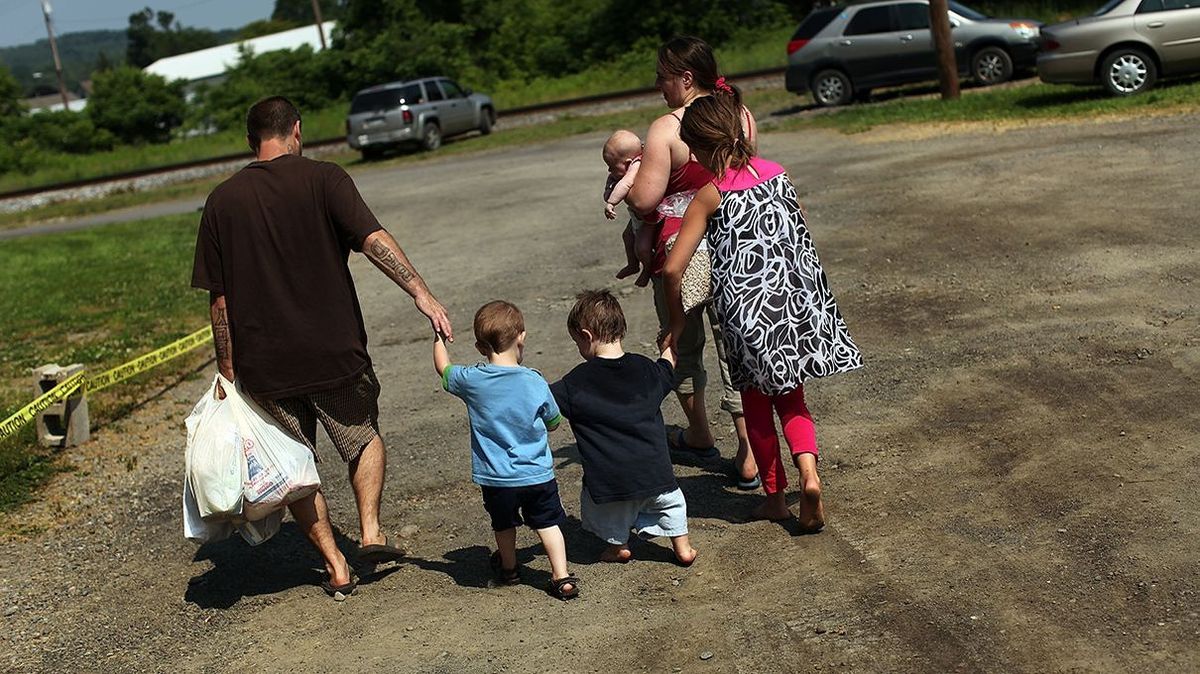A household collects meals from a meals financial institution in Upstate New York in 2016. Spencer Platt/Getty Pictures
We’re used to excited about poverty as a measure of earnings: poor individuals make little or no cash, and consequently, they’re unable to afford to purchase the fundamentals like meals, housing, and well being care. The U.S. Census Bureau decides every year what the earnings threshold goes to be to outline the federal poverty line; in 2016, that threshold is round $16,000 per 12 months for a household of two, and just a little over $24,000 for a household of 4.
However is earnings the one knowledge level we should always acquire after we’re making an attempt to find out about poverty in America? Different nations like Bhutan, Colombia, Chile, Malaysia and Mexico all measure poverty with a multidimensional index — Mexico, for example, appears at earnings alongside training, housing, well being, social cohesion, and entry to meals. However each nation is totally different, and a multidimensional poverty index ought to look totally different in a rustic the place dwelling in a home with out electrical energy, a everlasting flooring or sanitation services is not all that unusual, in comparison with the US, the place many individuals in poverty have these issues that somewhere else is perhaps thought of luxuries.
“”
In line with the US Census Bureau, Mississippi is the nation’s poorest state, with a median earnings of $39,680.
Spencer Platt/Getty Pictures
A brand new examine within the journal Social Indicators Analysis proposes simply such a multidimensional strategy to poverty within the U.S. It could result in extra correct assessments, it argues, of whether or not the essential wants are being met inside a family.
"The federal poverty line was arrange throughout Lyndon Johnson’s Struggle on Poverty — that is how dated the poverty line is," says writer Shatakshee Dhongde, an assistant professor within the College of Economics at Georgia Tech. "It has been up to date with respect to inflation, however what hasn’t modified is the notion of earnings, what you embrace in earnings, and the method that was established again within the 1960’s to inform whether or not households are in a position to meet their fundamental wants — that hasn’t modified."
Up to now few years, the Census Bureau has created a tool to seize general lifestyle referred to as the Supplemental Poverty Measure. It appears at a broader notion of earnings, and captures some elements of earnings the federal poverty line does not: bills on childcare and commuting to work, for instance. Dhongde and her co-author, Robert Haveman, professor emeritus on the College of Wisconsin-Madison Institute for Analysis on Poverty, argue that whereas that is useful, it is not sufficient as a result of it’s nonetheless based mostly fully on earnings.
"We have to look past earnings," says Dhongde.
Dhongde and Haveman have outlined poverty as "deprivation" of requirements moderately than a hard and fast earnings stage, suggesting a household is "multidimensionally disadvantaged" when they’re unable to fulfill their wants in two of six totally different dimensions:
• well being
• training
• lifestyle
• safety
• social connections
• housing high quality
They checked out knowledge from the American Neighborhood Survey carried out by the U.S. Census Bureau, measuring nearly 3 million observations per 12 months, spanning the Nice Recession within the U.S., from 2008 to 2013. This big knowledge set allowed them to take a look at depravation dimensions past earnings, and although their evaluation discovered solely a small distinction between the income-based poverty charge (13.2 p.c) throughout the recession and the multi-dimensional deprivation index (14.9 p.c), they discovered there solely a 6.6 p.c overlap between the 2 teams. The 2 teams, due to this fact, had been nearly completely separate.
When it got here to deprivation, the scale which had been most typical for People had been lack of training, extreme housing burden, and lack of medical health insurance. In addition they checked out deprivation by age group, and located younger adults aged 18 to 24 face lots of deprivations as they enter the job market. By race and ethnicity, it is truthful to say that there is a stereotype in in style tradition of the African-American inhabitants making up a big proportion of the poor on this nation — incoming president Donald Trump incessantly equates black America with internal cities and hellish dwelling circumstances, regardless of the number of experiences in that neighborhood, for example — however by this index, it seems Asians and Hispanics take care of very excessive ranges of deprivation as effectively. When you’re male- versus female-headed households, single male-headed households have one of many largest deprivation ranges.
"These are the insights you get if you cease measuring individuals with only one yardstick," says Dhongde.
Now That is Attention-grabbing
In 1964, Mollie Orshansky, a civil servant working within the Social Safety workplace, created the primary official measurement of poverty utilized by the U.S. authorities. The third of six daughters born to Jewish Ukrainian immigrants, she as soon as mentioned, "If I write concerning the poor, I do not want a great creativeness — I’ve a great reminiscence."

